Superposition Principle
Superposition Principle: Overview
This topic covers concepts, such as, Superposition Principle & Force on a Charge Due to Two or More Charges etc.
Important Questions on Superposition Principle
A hemisphere is uniformly charged positively. The electric field at a point on a diameter away from the centre is directed
Three charges each of are placed at the corners of an equilateral triangle. If the force between any two charges be , then the net force on either charge will be:
Two identical positive charges are fixed at and A particle with negative charge starts from negative axis at a large distance from moves along the axis, passes through and moves far away from The particle's acceleration is is plotted against its coordinate. Which of the following best represents the plot?
Three large identical conducting sheets, each having a surface area of is placed parallel to each other at finite distance contain charges and . What is the magnitude of electric field at point?
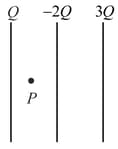
Which of the following figures correctly shows the top view sketch of the electric field lines for a uniformly charged hollow cylinder as shown in figure? 
A unit negative charge with mass resides at the mid-point of the straight line of length adjoining two fixed charges of magnitude each. If it is given a very small displacement in a direction perpendicular to the straight line, it will
A charge exerts some force on a second charge . If third charge is brought near, the force of exerted on
A charge is located at the origin in free space and another charge at . If the -component of the electric field at is zero, then the magnitudes of in is
A uniform surface charge density exists over the entire plane except for a circular hole of radius a centred at the origin. The electric field at a point on the -axis is found to be
In a regular polygon of sides, each corner is at a distance from centre. Identical charges of magnitude are placed at corners. The field at the centre is
A regular polygon has sides. Equal charges, each , are placed at vertices of the polygon and a charge is placed at the centre of the polygon. If the distance of each vertex from the centre is , net force experienced by is
In the basic crystal structure, and ions are arranged in a BCC configuration as shown in Fig. The net electrostatic force exerted by the eight ions on the ion is
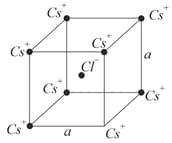
Four equal charges, each are placed at the four corners of a square of side . Then the Coulomb force experienced by one charge due to the rest of three is
If two like charges of magnitude and are separated by a distance of , then the point on the line joining the charges, where the force experienced by a charge placed at that point is zero, is
Vertices of a regular hexagon, of sides , have three positive and three negative charges, each of magnitude , as shown in the diagram. A point charge of is placed at the centre of the hexagon. The net force on is
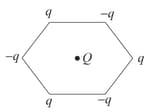
Vertices of a regular hexagon of sides have three positive and negative charges each of magnitude as shown in diagram. A point charge of is placed at centre of hexagon. The net force on is -
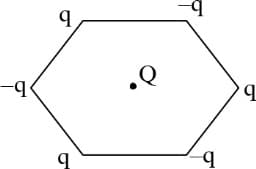
Three charges are placed at the vertices of an equilateral triangle of sides . The force experienced by the charge placed at the vertex in a direction normal to is
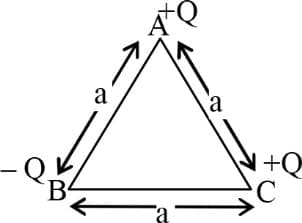
Three charges, each of coulomb are placed as shown in the figure. Then the net force on the charge placed at the origin is -

The charge is placed at each of the two opposite corners of a square and a charge is placed at each of the other two opposite corners. If charges are fixed, then for equilibrium of , it is required that-
Two identical balls each having a density are suspended from a common point by two insulating strings of equal length. Both the balls have equal mass and charge. In equilibrium, each string makes an angle with the vertical. Now, both the balls are immersed in a liquid of density , but the angle does not change. The dielectric constant of the liquid is -
